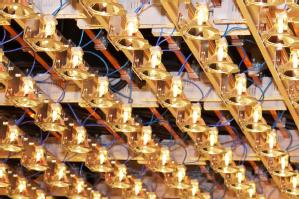Sarah Keay-Bright
lamps of a solar simulator
What got you interested in this area of science?
I have always been interested in science since school. I loved maths, science and all my other subjects too. Perhaps thats why I consider myself to be an interdisciplinarian. In 1998 I went to the University of Oxford to study for a Masters in Environmental Change & Management. On this course I learned a great deal about climate change and the complexity of our energy system and possible low carbon solutions. I work in the area of energy efficiency and renewable energy because it is fascinating, bringing together so many different disciplines, but moreover because of the very urgent need to decarbonise our energy system. I am now the Project Manager for the Science City Energy Efficiency project.
How is the work you are currently doing relevant to everyday
life? The work of the Science City Energy Efficiency project affects all aspects of everyday life because our energy system is fundamental to most human economic activity. The project covers efficient solar and thermal technologies, as represented through the picture of these solar lamps, but also cars powered by electricity or low carbon liquid fuels, smart electricity control systems which help us to manage energy use better, and power electronics which can be found in nearly all appliances, phones and cars. Within the next ten years we should be able to see technologies developed through this project in our cars and our homes.
What does your research hope to achieve?
Research conducted by the Sustainable Energy Engineering & Design team led by Professor Critoph will assist companies with the development of low-carbon heat driven refrigeration, air conditioning and heat pumping systems, solar heating systems and also analytical property measurement of materials used in these technologies. Such technological development will not only be good for the UK economy but will make a significant contribution to reducing carbon emissions too.
Briefly, what does the image show?
These are the lamps of a 3.2m2 continuous solar simulator which allows evaluation of the performance and detailed characterization of solar thermal and photovoltaic systems. The simulator can control radiation intensity, offers a cold sky condition and allows experimentation with a range of wind velocities. It can also be titled from vertical to 60˚ so the effect of the radiation incidence angle on solar thermal and photovoltaic materials and products can be evaluated. Its large size means that whole products - not just small samples - can be tested.


